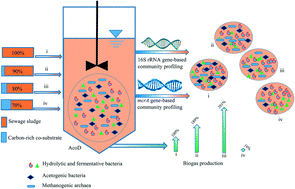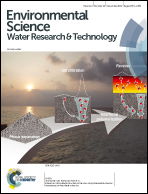Impact of anaerobic co-digestion between sewage sludge and carbon-rich organic waste on microbial community resilience†
Abstract
This study examines the changes in microbial community diversity and structure in response to anaerobic co-digestion (AcoD) between sewage sludge and a carbon-rich organic waste. Biomass samples were collected at different carbon-rich co-substrate mixing ratios to cover a large range of organic loading rate (OLR) for microbial community analysis by amplicon sequencing of 16S rRNA and mcrA marker genes on the Illumina Miseq platform. The results show a reduction in community diversity (i.e. richness and evenness) and a shift in community structure as the OLR increased due to the addition of the carbon-rich co-substrate. Despite the decrease in community diversity, biogas production increased proportionally to the increase in OLR of up to 3.03 kg COD per m3 per day (corresponding to 171% OLR increase compared to anaerobic digestion of only sewage sludge). Further OLR increase led to the collapse of biogas production as well as significant reduction in both the microbial diversity and methanogenic population. The methanogenic community was more sensitive to the increase in OLR compared to hydrolytic and fermentative bacteria. These results show that there is an OLR threshold at which the function and resilience of the anaerobic ecosystem could be maintained. Beyond this threshold, the enrichment of hydrolytic and fermentative bacteria, as well as inhibition of methanogenic community, can cause anaerobic digestion failure.



 Please wait while we load your content...
Please wait while we load your content...